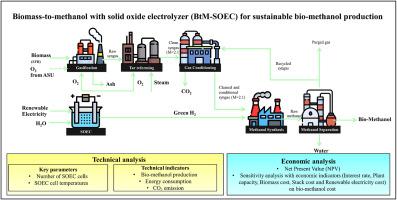Techno-economic performance analysis of biomass-to-methanol with solid oxide electrolyzer for sustainable bio-methanol production
IF 9
1区 工程技术
Q1 ENERGY & FUELS
引用次数: 0
Abstract
The analysis of the technical and economic performance of an integrated biomass to methanol and solid oxide electrolysis process (BtM-SOEC) is studied to find more sustainable process of bio-methanol production. The oil palm empty fruit branch (EFB) which is abundant in Thailand is used as biomass feedstock. Modeling of the BtM-SOEC is done using Aspen Plus. For technical aspects, the production rate of oxygen and hydrogen from the SOEC can be enhanced through an appropriate adjustment of the number of cells and cell temperature. The BtM-SOEC offers higher methanol yield and overall efficiency, while consumes less energy than the conventional biomass to methanol process (BtM). The maximum methanol production rate of 0.4995 kmol hr−1 derived from BtM-SOEC is achieved at a number of cells of 325 cells and a cell temperature of 700 °C, at this condition the overall efficiency is 64.79 %. The economic assessment indicates that the conventional BtM and BtM-SOEC are still not economically feasible. However, the conventional BtM is more economically feasible than the BtM-SOEC. The methanol cost of BtM-SOEC can turn out to be economically feasible when renewable electricity cost and SOEC cost decrease substantially. The methanol cost of the BtM-SOEC (620 USD ton−1) can be competitive to that of the BtM (703 USD ton−1) when the cost of input renewable electricity decreases by 80 %. Consequently, this research highlights the potential of BtM-SOEC from agricultural residues for sustainable bio-methanol production in the future market condition that the cost of renewable electricity tends to continuously decrease with the technology development and increased technology adoption and the carbon policy tends to be tightened to relieve global warming.

利用固体氧化物电解槽生产生物质转化甲醇以实现可持续生物甲醇生产的技术经济性能分析
研究分析了生物质制甲醇和固体氧化物电解综合工艺(BtM-SOEC)的技术和经济性能,以找到更可持续的生物甲醇生产工艺。泰国盛产的油棕空果枝(EFB)被用作生物质原料。使用 Aspen Plus 对 BtM-SOEC 进行建模。在技术方面,可以通过适当调整电池数量和电池温度来提高 SOEC 的氧气和氢气生产率。与传统的生物质制甲醇工艺(BtM)相比,BtM-SOEC 具有更高的甲醇产量和整体效率,同时能耗更低。在电池数量为 325 个、电池温度为 700 °C 的条件下,BtM-SOEC 的最大甲醇生产率为 0.4995 kmol hr-1,总效率为 64.79 %。经济评估表明,传统 BtM 和 BtM-SOEC 在经济上仍然不可行。不过,传统 BtM 比 BtM-SOEC 更经济可行。当可再生电力成本和 SOEC 成本大幅下降时,BtM-SOEC 的甲醇成本就会变得经济可行。当输入的可再生电力成本降低 80% 时,BtM-SOEC 的甲醇成本(620 美元/吨-1)与 BtM(703 美元/吨-1)相比具有竞争力。因此,这项研究强调了利用农业残留物生产 BtM-SOEC 生物甲醇在未来市场条件下的潜力,即随着技术的发展和技术应用的增加,可再生电力的成本趋于持续下降,以及碳政策趋于收紧以缓解全球变暖。
本文章由计算机程序翻译,如有差异,请以英文原文为准。
求助全文
约1分钟内获得全文
求助全文
来源期刊

Energy
工程技术-能源与燃料
CiteScore
15.30
自引率
14.40%
发文量
0
审稿时长
14.2 weeks
期刊介绍:
Energy is a multidisciplinary, international journal that publishes research and analysis in the field of energy engineering. Our aim is to become a leading peer-reviewed platform and a trusted source of information for energy-related topics.
The journal covers a range of areas including mechanical engineering, thermal sciences, and energy analysis. We are particularly interested in research on energy modelling, prediction, integrated energy systems, planning, and management.
Additionally, we welcome papers on energy conservation, efficiency, biomass and bioenergy, renewable energy, electricity supply and demand, energy storage, buildings, and economic and policy issues. These topics should align with our broader multidisciplinary focus.
 求助内容:
求助内容: 应助结果提醒方式:
应助结果提醒方式:


